物流和供应链管理的演变与未来【外文翻译】
- 格式:doc
- 大小:72.50 KB
- 文档页数:9
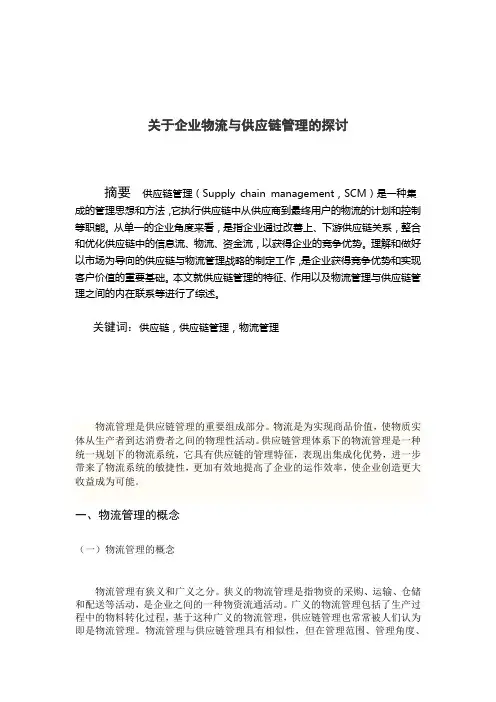
关于企业物流与供应链管理的探讨摘要供应链管理(Supply chain management,SCM)是一种集成的管理思想和方法,它执行供应链中从供应商到最终用户的物流的计划和控制等职能。
从单一的企业角度来看,是指企业通过改善上、下游供应链关系,整合和优化供应链中的信息流、物流、资金流,以获得企业的竞争优势。
理解和做好以市场为导向的供应链与物流管理战略的制定工作,是企业获得竞争优势和实现客户价值的重要基础。
本文就供应链管理的特征、作用以及物流管理与供应链管理之间的内在联系等进行了综述。
关键词:供应链,供应链管理,物流管理物流管理是供应链管理的重要组成部分。
物流是为实现商品价值,使物质实体从生产者到达消费者之间的物理性活动。
供应链管理体系下的物流管理是一种统一规划下的物流系统,它具有供应链的管理特征,表现出集成化优势,进一步带来了物流系统的敏捷性,更加有效地提高了企业的运作效率,使企业创造更大收益成为可能。
一、物流管理的概念(一)物流管理的概念物流管理有狭义和广义之分。
狭义的物流管理是指物资的采购、运输、仓储和配送等活动,是企业之间的一种物资流通活动。
广义的物流管理包括了生产过程中的物料转化过程,基于这种广义的物流管理,供应链管理也常常被人们认为即是物流管理。
物流管理与供应链管理具有相似性,但在管理范围、管理角度、组织内部关系等方面又有明显的区别。
由此可以看出,供应链管理源于物流管理,物流管理是供应链管理的重要内容,供应链管理的实效很大程度上取决于采购、运输、仓储和配送等物流作业环节的管理和运作状况。
因此,物流管理是供应链管理发挥整体效益的前提和基础。
(二)物流管理分类由下图可以看出制造业物流可分为采购物流、厂内物流、销售物流、退货物流、废弃物回收物流。
(三)企业对物流活动的认识企业对物流活动的认识和措施的变化,大致可分为以下四个阶段,下表物流作用的变化:物流中心 退货物流公司内部物流 公司内部物流 生产物流 公司内部物流 废弃物流 销售物流(接收、保管、付出)1.切实保证运输的时代(1955年--1964年)。
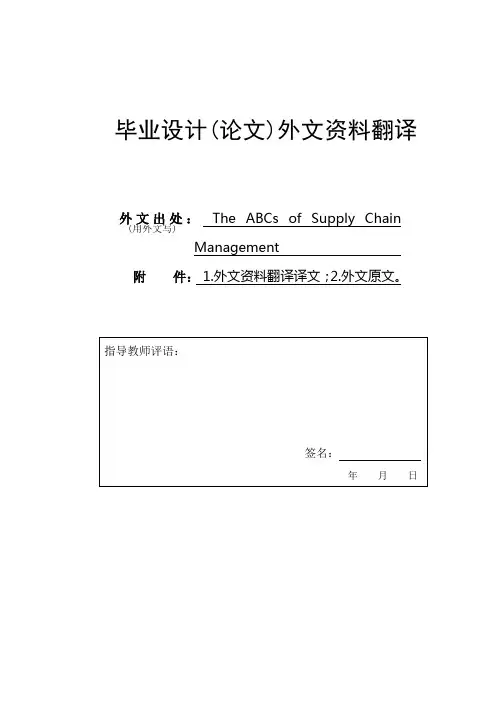
毕业设计(论文)外文资料翻译外文出处:The ABCs of Supply Chain (用外文写)Management附件:1.外文资料翻译译文;2.外文原文。
附件1:外文资料翻译译文供应链管理ABC1.什么是供应链管理供应链是一种关于整合的科学和艺术,它主要探究提高企业采购生产商品所需的原材料、生产商品,并把它供应给最终顾客的效率的途径。
以下是供应链管理的五个基本组成模块:计划--它是供应链的战略层面。
企业需要有一个控制所有资源的战略以满足客户对产品或服务的需求。
计划的核心是建立一套机制去监控整条供应链以便使它能有效运作:低成本、高品质配送和增值客户服务。
该模块连结着供应链的作业与营运目标,主要包括需求/供给规划(Demand/Supply Planning)与规划基础建设(infrastructure)两项活动,对所有采购运筹流程、制造运筹流程与配送运筹流程进行规划与控制。
需求/供给规划活动包含了评估企业整体产能与资源、总体需求规划以及针对产品与配销管道,进行存货规划、配送规划、制造规划、物料及产能的规划。
规划基础建设管理包含了自制或外包决策的制定、供应链的架构设计、长期产能与资源规划、企业规划、产品生命周期的决定、新旧产品线规划与产品线的管理等。
采购—选择供给你提供用来生产产品或服务的原材料或服务的供应商。
和供应商建立一套价格、供应、支付过程的体系,创造一种机制以监控此过程、改善供应商关系。
理顺此过程以管理供应商交付的原材料库存或服务,其中包括收货、出货、检验、中转和批准支付。
此模块有采购作业与采购基础建设两项管理活动,其目的是描述一般的采购作业与采购管理流程。
采购作业包含了寻找供货商、收料、进料品检、拒收与发料作业。
采购基础建设的管理包含了供货商评估、采购、运输管理、采购品质管理、采购合约管理、付款条件管理、采购零组件的规格制定。
制造—这是制造步骤。
计划这些必需的活动:生产、测试、包装、预出货。
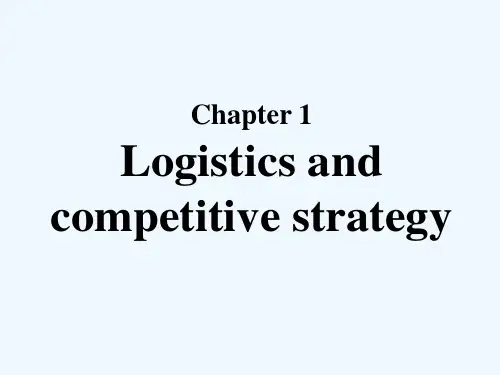
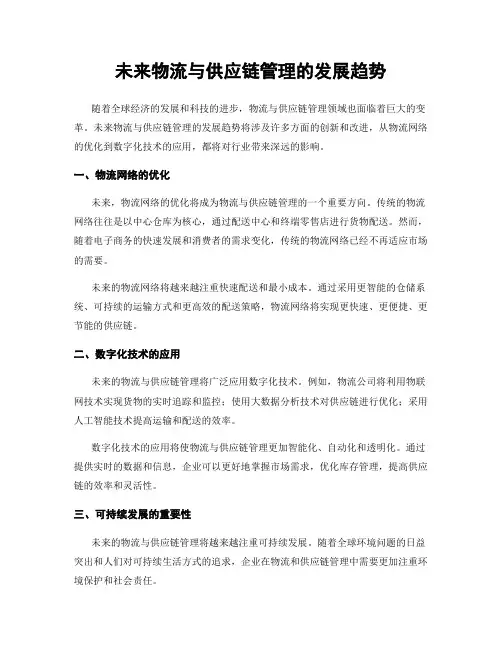
未来物流与供应链管理的发展趋势随着全球经济的发展和科技的进步,物流与供应链管理领域也面临着巨大的变革。
未来物流与供应链管理的发展趋势将涉及许多方面的创新和改进,从物流网络的优化到数字化技术的应用,都将对行业带来深远的影响。
一、物流网络的优化未来,物流网络的优化将成为物流与供应链管理的一个重要方向。
传统的物流网络往往是以中心仓库为核心,通过配送中心和终端零售店进行货物配送。
然而,随着电子商务的快速发展和消费者的需求变化,传统的物流网络已经不再适应市场的需要。
未来的物流网络将越来越注重快速配送和最小成本。
通过采用更智能的仓储系统、可持续的运输方式和更高效的配送策略,物流网络将实现更快速、更便捷、更节能的供应链。
二、数字化技术的应用未来的物流与供应链管理将广泛应用数字化技术。
例如,物流公司将利用物联网技术实现货物的实时追踪和监控;使用大数据分析技术对供应链进行优化;采用人工智能技术提高运输和配送的效率。
数字化技术的应用将使物流与供应链管理更加智能化、自动化和透明化。
通过提供实时的数据和信息,企业可以更好地掌握市场需求,优化库存管理,提高供应链的效率和灵活性。
三、可持续发展的重要性未来的物流与供应链管理将越来越注重可持续发展。
随着全球环境问题的日益突出和人们对可持续生活方式的追求,企业在物流和供应链管理中需要更加注重环境保护和社会责任。
物流企业将采用更环保的运输方式,减少物流环节中的能源消耗和废物排放。
同时,通过推进绿色采购和供应链的可持续管理,企业可以减少对资源的浪费,提高资源利用效率。
四、全球化与供应链协同未来物流与供应链管理将面临全球化和供应链协同的挑战。
全球化使得物流网络变得更加复杂,供应链的各个环节需要协同工作以实现全球范围内的货物运输和交付。
供应链的协同不仅需要依靠物流企业之间的合作,还需要利用信息技术和数字化平台实现。
未来,供应链的协同将更加智能化和高效化,通过信息共享和协同决策,实现供应链的顺畅运作。
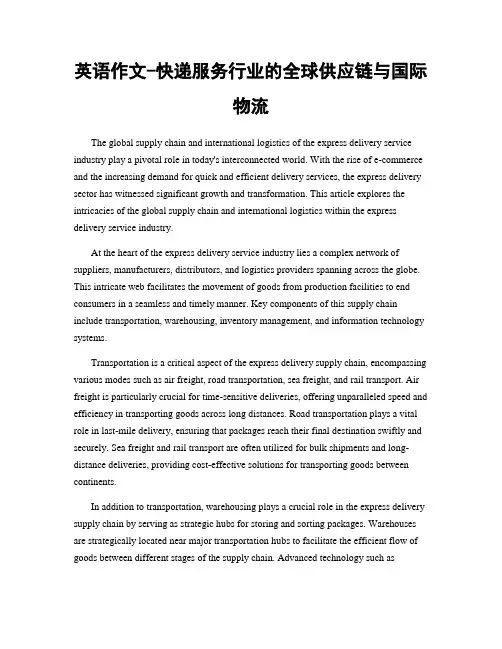
英语作文-快递服务行业的全球供应链与国际物流The global supply chain and international logistics of the express delivery service industry play a pivotal role in today's interconnected world. With the rise of e-commerce and the increasing demand for quick and efficient delivery services, the express delivery sector has witnessed significant growth and transformation. This article explores the intricacies of the global supply chain and international logistics within the express delivery service industry.At the heart of the express delivery service industry lies a complex network of suppliers, manufacturers, distributors, and logistics providers spanning across the globe. This intricate web facilitates the movement of goods from production facilities to end consumers in a seamless and timely manner. Key components of this supply chain include transportation, warehousing, inventory management, and information technology systems.Transportation is a critical aspect of the express delivery supply chain, encompassing various modes such as air freight, road transportation, sea freight, and rail transport. Air freight is particularly crucial for time-sensitive deliveries, offering unparalleled speed and efficiency in transporting goods across long distances. Road transportation plays a vital role in last-mile delivery, ensuring that packages reach their final destination swiftly and securely. Sea freight and rail transport are often utilized for bulk shipments and long-distance deliveries, providing cost-effective solutions for transporting goods between continents.In addition to transportation, warehousing plays a crucial role in the express delivery supply chain by serving as strategic hubs for storing and sorting packages. Warehouses are strategically located near major transportation hubs to facilitate the efficient flow of goods between different stages of the supply chain. Advanced technology such asautomated storage and retrieval systems, barcode scanning, and inventory management software optimize warehouse operations and enhance productivity.Effective inventory management is essential for minimizing costs and maximizing efficiency within the express delivery supply chain. By maintaining optimal inventory levels and implementing just-in-time inventory practices, companies can reduce carrying costs while ensuring product availability to meet customer demand. Real-time tracking and monitoring systems enable companies to accurately track the movement of goods throughout the supply chain, providing visibility and transparency to both businesses and consumers.Information technology plays a central role in facilitating communication and collaboration within the express delivery supply chain. Advanced software solutions enable seamless integration of various supply chain processes, allowing for real-time data exchange and decision-making. Electronic data interchange (EDI), cloud computing, and blockchain technology are increasingly being adopted to enhance the efficiency, security, and transparency of supply chain operations.In conclusion, the global supply chain and international logistics of the express delivery service industry are essential drivers of global trade and commerce. By leveraging advanced technology, strategic partnerships, and efficient processes, companies can streamline supply chain operations, reduce costs, and enhance customer satisfaction. As e-commerce continues to proliferate and consumer expectations evolve, the express delivery sector must continually innovate and adapt to meet the growing demands of a dynamic marketplace.。
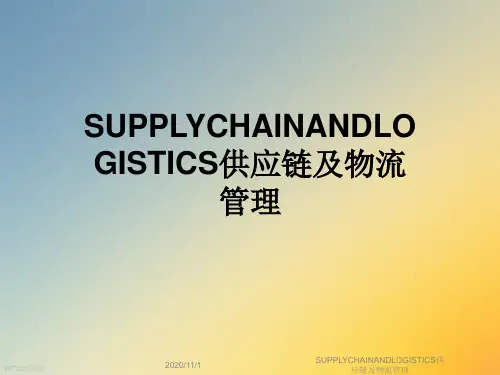
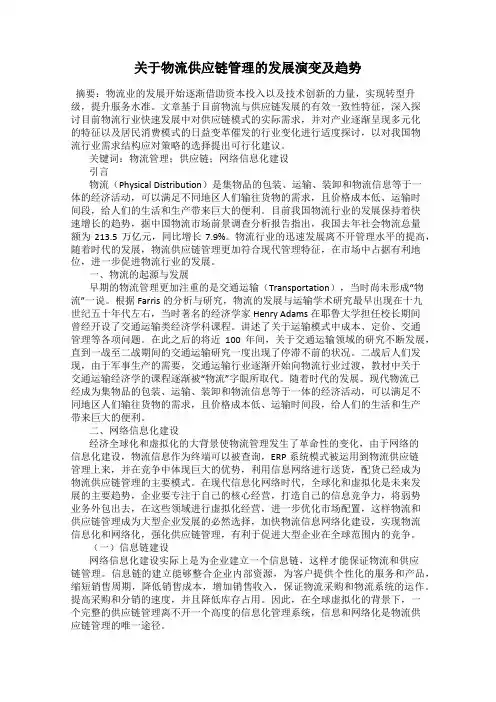
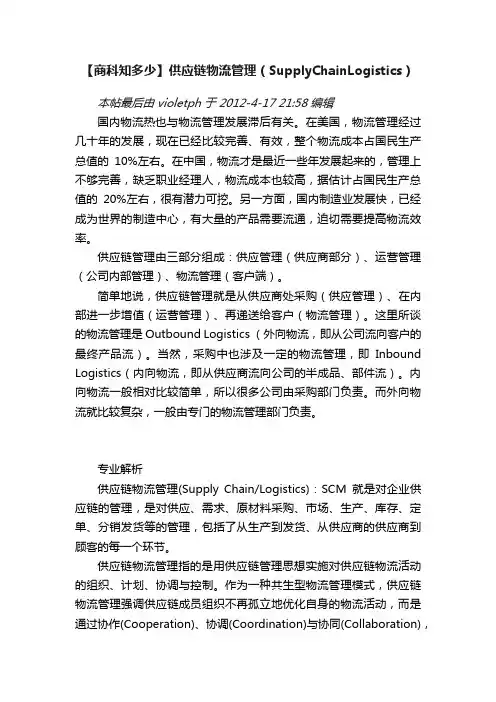
【商科知多少】供应链物流管理(SupplyChainLogistics)本帖最后由 violetph 于 2012-4-17 21:58 编辑国内物流热也与物流管理发展滞后有关。
在美国,物流管理经过几十年的发展,现在已经比较完善、有效,整个物流成本占国民生产总值的10%左右。
在中国,物流才是最近一些年发展起来的,管理上不够完善,缺乏职业经理人,物流成本也较高,据估计占国民生产总值的20%左右,很有潜力可挖。
另一方面,国内制造业发展快,已经成为世界的制造中心,有大量的产品需要流通,迫切需要提高物流效率。
供应链管理由三部分组成:供应管理(供应商部分)、运营管理(公司内部管理)、物流管理(客户端)。
简单地说,供应链管理就是从供应商处采购(供应管理)、在内部进一步增值(运营管理)、再递送给客户(物流管理)。
这里所谈的物流管理是Outbound Logistics (外向物流,即从公司流向客户的最终产品流)。
当然,采购中也涉及一定的物流管理,即Inbound Logistics(内向物流,即从供应商流向公司的半成品、部件流)。
内向物流一般相对比较简单,所以很多公司由采购部门负责。
而外向物流就比较复杂,一般由专门的物流管理部门负责。
专业解析供应链物流管理(Supply Chain/Logistics):SCM就是对企业供应链的管理,是对供应、需求、原材料采购、市场、生产、库存、定单、分销发货等的管理,包括了从生产到发货、从供应商的供应商到顾客的每一个环节。
供应链物流管理指的是用供应链管理思想实施对供应链物流活动的组织、计划、协调与控制。
作为一种共生型物流管理模式,供应链物流管理强调供应链成员组织不再孤立地优化自身的物流活动,而是通过协作(Cooperation)、协调(Coordination)与协同(Collaboration),提高供应链物流的整体效率。
物流是指为了满足客户的需要,以最低的成本,通过运输、保管、配送等方式,实现原材料、半成品、成品及相关信息由商品的产地到商品的消费地所进行的计划、实施和管理的全过程。

本科毕业论文(设计)外文翻译原文:Multi-echelon inventory management in supply chains Historically, the echelons of the supply chain, warehouse, distributors, retailers, etc., have been managed independently, buffered by large inventories. Increasing competitive pressures and market globalization are forcing firms to develop supply chains that can quickly respond to customer needs. To remain competitive and decrease inventory, these firms must use multi-echelon inventory management interactively, while reducing operating costs and improving customer service.Supply chain management (SCM) is an integrative approach for planning and control of materials and information flows with suppliers and customers, as well as between different functions within a company. This area has drawn considerable attention in recent years and is seen as a tool that provides competitive power .SCM is a set of approaches to integrate suppliers, manufacturers, warehouses, and stores efficiently, so that merchandise is produced and distributed at right quantities, to the right locations and at the right time, in order to minimize system-wide costs while satisfying service-level requirements .So the supply chain consists of various members or stages. A supply chain is a dynamic, stochastic, and complex system that might involve hundreds of participants.Inventory usually represents from 20 to 60 per cent of the total assets of manufacturing firms. Therefore, inventory management policies prove critical in determining the profit of such firms. Inventory management is, to a greater extent, relevant when a whole supply chain (SC), namely a network of procurement, transformation, and delivering firms, is considered. Inventory management is indeed a major issue in SCM, i.e. an approach that addresses SC issues under an integrated perspective.Inventories exist throughout the SC in various forms for various reasons. Thelack of a coordinated inventory management throughout the SC often causes the bullwhip effect, namely an amplification of demand variability moving towards the upstream stages. This causes excessive inventory investments, lost revenues, misguided capacity plans, ineffective transportation, missed production schedules,and poor customer service.Many scholars have studied these problems, as well as emphasized the need of integration among SC stages, to make the chain effectively and efficiently satisfy customer requests (e.g. reference). Beside the integration issue, uncertainty has to be dealt with in order to define an effective SC inventory policy. In addition to the uncertainty on supply (e.g. lead times) and demand, information delays associated with the manufacturing and distribution processes characterize SCs.Inventory management in multi-echelon SCs is an important issue, because thereare many elements that have to coordinate with each other. They must also arrangetheir inventories to coordinate. There are many factors that complicate successful inventory management, e.g. uncertain demands, lead times, production times, product prices, costs, etc., especially the uncertainty in demand and lead times where the inventory cannot be managed between echelons optimally.Most manufacturing enterprises are organized into networks of manufacturingand distribution sites that procure raw material, process them into finished goods, and distribute the finish goods to customers. The terms ‘multi-echelon’ or ‘multilevel‘production/distribution networks are also synonymous with such networks(or SC), when an item moves through more than one step before reaching the final customer. Inventories exist throughout the SC in various forms for various reasons. Atany manufacturing point, they may exist as raw materials, work in progress, or finished goods. They exist at the distribution warehouses, and they exist in-transit, or‘in the pipeline’, on each path linking these facilities.Manufacturers procure raw material from suppliers and process them into finished goods, sell the finished goods to distributors, and then to retail and/or customers. When an item moves through more than one stage before reaching thefinal customer, it forms a ‘multi-echelon’ inventory system. The echelon stock of a stock point equals all stock at this stock point, plus in-transit to or on-hand at any of its downstream stock points, minus the backorders at its downstream stock points.The analysis of multi-echelon inventory systems that pervades the business world has a long history. Multi-echelon inventory systems are widely employed to distribute products to customers over extensive geographical areas. Given the importance of these systems, many researchers have studied their operating characteristics under a variety of conditions and assumptions. Since the development of the economic order quantity (EOQ) formula by Harris (1913), researchers and practitioners have been actively concerned with the analysis and modeling of inventory systems under different operating parameters and modeling assumptions .Research on multi-echelon inventory models has gained importance over the last decade mainly because integrated control of SCs consisting of several processing and distribution stages has become feasible through modern information technology. Clark and Scarf were the first to study the two-echelon inventory model. They proved the optimality of a base-stock policy for the pure-serial inventory system and developed an efficient decomposing method to compute the optimal base-stock ordering policy. Bessler and Veinott extended the Clark and Scarf model to include general arbores cent structures. The depot-warehouse problem described above was addressed by Eppen and Schrage who analyzed a model with a stockless central depot. They derived a closed-form expression for the order-up-to-level under the equal fractile allocation assumption. Several authors have also considered this problem in various forms. Owing to the complexity and intractability of the multi-echelon problem Hadley and Whitin recommend the adoption of single-location, single-echelon models for the inventory systems.Sherbrooke considered an ordering policy of a two-echelon model for warehouse and retailer. It is assumed that stock outs at the retailers are completely backlogged. Also, Sherbrooke constructed the METRIC (multi-echelon technique for coverable item control) model, which identifies the stock levels that minimize the expected number of backorders at the lower-echelon subject to a bud get constraint. This modelis the first multi-echelon inventory model for managing the inventory of service parts. Thereafter, a large set of models which generally seek to identify optimal lot sizes and safety stocks in a multi-echelon framework, were produced by many researchers. In addition to analytical models, simulation models have also been developed to capture the complex interaction of the multi-echelon inventory problems.So far literature has devoted major attention to the forecasting of lumpy demand, and to the development of stock policies for multi-echelon SCs Inventory control policy for multi-echelon system with stochastic demand has been a widely researched area. More recent papers have been covered by Silver and Pyke. The advantage of centralized planning, available in periodic review policies, can be obtained in continuous review policies, by defining the reorder levels of different stages, in terms of echelon stock rather than installation stock.Rau et al. , Diks and de Kok , Dong and Lee ,Mitra and Chatterjee , Hariga , Chen ,Axsater and Zhang , Nozick and Turnquist ,and So and Zheng use a mathematic modeling technique in their studies to manage multi-echelon inventory in SCs. Diks and de Kok’s study considers a divergent multi-echelon inventory system, such as a distribution system or a production system, and assumes that the order arrives after a fixed lead time. Hariga, presents a stochastic model for a single-period production system composed of several assembly/processing and storage facilities in series. Chen, Axsater and Zhang, and Nozick and Turnquist consider a two-stage inventory system in their papers. Axsater and Zhang and Nozickand Turnquist assume that the retailers face stationary and independent Poisson demand. Mitra and Chatterjee examine De Bodt and Graves’ model (1985), which they developed in their paper’ Continuous-review policies for a multi-echelon inventory problem with stochastic demand’, for fast-moving items from the implementation point of view. The proposed modification of the model can be extended to multi-stage serial and two -echelon assembly systems. In Rau et al.’s model, shortage is not allowed, lead time is assumed to be negligible, and demand rate and production rate is deterministic and constant. So and Zheng used an analytical model to analyze two important factors that can contribute to the high degree of order-quantity variability experienced bysemiconductor manufacturers: supplier’s lead time and forecast demand updating. They assume that the external demands faced by there tailor are correlated between two successive time periods and that the retailer uses the latest demand information to update its future demand forecasts. Furthermore, they assume that the supplier’s delivery lead times are variable and are affected by the retailer’s order quantities. Dong and Lee’s paper revisits the serial multi-echelon inventory system of Clark and Scarf and develops three key results. First, they provide a simple lower-bound approximation to the optimal echelon inventory levels and an upper bound to the total system cost for the basic model of Clark and Scarf. Second, they show that the structure of the optimal stocking policy of Clark and Scarf holds under time-correlated demand processing using a Martingale model of forecast evolution. Third, they extend the approximation to the time-correlated demand process and study, in particular for an autoregressive demand model, the impact of lead times, and autocorrelation on the performance of the serial inventory system.After reviewing the literature about multi-echelon inventory management in SCs using mathematic modeling technique, it can be said that, in summary, these papers consider two, three, or N-echelon systems with stochastic or deterministic demand. They assume lead times to be fixed, zero, constant, deterministic, or negligible. They gain exact or approximate solutions.Dekker et al. analyses the effect of the break-quantity rule on the inventory costs. The break-quantity rule is to deliver large orders from the warehouse, and small orders from the nearest retailer, where a so-called break quantity determines whether an order is small or large. In most l-warehouse–N-retailers distribution systems, it is assumed that all customer demand takes place at the retailers. However, it was shown by Dekker et al. that delivering large orders from the warehouse can lead to a considerable reduction in the retailer’s inventory costs. In Dekker et al. the results of Dekker et al. were extended by also including the inventory costs at the warehouse. The study by Mohebbi and Posner’s contains a cost analysis in the context of a continuous-review inventory system with replenishment orders and lost sales. The policy considered in the paper by V ander Heijden et al. is an echelon stock, periodicreview, order-up-to policy, under both stochastic demand and lead times.The main purpose of Iida’s paper is to show that near-myopic policies are acceptable for a multi-echelon inventory problem. It is assumed that lead times at each echelon are constant. Chen and Song’s objective is to minimize the long-run average costs in the system. In the system by Chen et al., each location employs a periodic-review, or lot-size reorder point inventory policy. They show that each location’s inventory positions are stationary and the stationary distribution is uniform and independent of any other. In the study by Minner et al., the impact of manufacturing flexibility on inventory investments in a distribution network consisting of a central depot and a number of local stock points is investigated. Chiang and Monahan present a two-echelon dual-channel inventory model in which stocks are kept in both a manufacturer warehouse (upper echelon) and a retail store (lower echelon), and the product is available in two supply channels: a traditional retail store and an internet-enabled direct channel. Johansen’s system is assumed to be controlled by a base-stock policy. The independent and stochastically dependent lead times are compared.To sum up, these papers consider two- or N-echelon inventory systems, with generally stochastic demand, except for one study that considers Markov-modulated demand. They generally assume constant lead time, but two of them accept it to be stochastic. They gain exact or approximate solutions.In multi-echelon inventory management there are some other research techniques used in literature, such as heuristics, vary-METRIC method, fuzzy sets, model predictive control, scenario analysis, statistical analysis, and GAs. These methods are used rarely and only by a few authors.A multi-product, multi-stage, and multi-period scheduling model is proposed by Chen and Lee to deal with multiple incommensurable goals for a multi-echelon SC network with uncertain market demands and product prices. The uncertain market demands are modeled as a number of discrete scenarios with known probabilities, and the fuzzy sets are used for describing the sellers’ and buyers’ incompatible preference on product prices.In the current paper, a detailed literature review, conducted from an operational research point of view, is presented, addressing multi-echelon inventory management in supply chains from 1996 to 2005.Here, the behavior of the papers, against demand and lead time uncertainty, is emphasized.The summary of literature review is given as: the most used research technique is simulation. Also, analytic, mathematic, and stochastic modeling techniques are commonly used in literature. Recently, heuristics as fuzzy logic and GAs have gradually started to be used.Source: A Taskin Gu¨mu¨s* and A Fuat Gu¨neri Turkey, 2007. “Multi-echelon inventory management in supply chains with uncertain demand and lead times: literature review from an operational research perspective”. IMechE V ol. 221 Part B: J. Engineering Manufacture. June, pp.1553-1570.译文:供应链下的多级存货管理从历史上看,多级供应链、仓库、分销商、零售商等,已经通过大量的库存缓冲被独立管理。
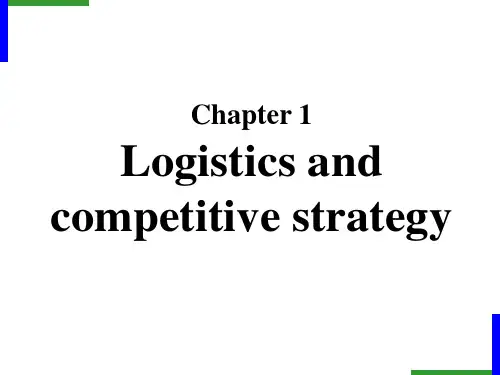

外文翻译 原文 The evolution and future of logistics and supply chain management Material Source: http://www.emeraldinsight.com Author:Ronald H. Ballou Before the 1950s, logistics was thought of in military terms. It had to do with procurement, maintenance, and transportation of military facilities, materiel, and personnel. Although a few authors before this time began talking about trading one cost for another, such as transportation costs with inventory costs, and discussed the benefits to the firm of getting the right goods to the right place at the right time, the organization within the typical firm around the activities currently associated with logistics was fragmented. Educational courses and programs at the time were not focused on logistics or distribution. They were mainly related to individual activities such as transportation and purchasing. There was little attempt to integrate and balance the activities later to be known as logistics activities that were in cost and/or service conflict. Hence, there was not much of an opportunity for managers to learn about the broader concepts of logistics. Physical distribution begins to emerge as an area of study and practice, which is the coordination of more than one activity associated with physically supplying product to the marketplace. LaLonde and Dawson (1969) trace the early history and note that Arch Shaw in 1912 began to see the two sides of marketing, where one deals with demand creation (promotion) and the other with physical supply, and Fred Clark in 1922 identified the nature of physical distribution and pointed out how it was different from the demand-creating nature of marketing. Marketing as a discipline was generating interest at this time and scholars did include distribution as a primary activity in the marketing mix, however, distribution seemed to be defined more in terms of transaction channel activities than physical distribution ones. Converse (1954), a noted marketing professor, said in 1954 that businesses had been paying a great deal more attention to buying and selling than to physical distribution. In retrospect, research that would play a pivotal role in laying the foundations for physical distribution was a study by Lewis et al. (1956). This study for the airline industry asked how it might better compete in hauling freight when its costs were significantly higher than other forms of transportation. The study pointed out that it is necessary to view shipping from a total cost perspective and not from just a transportation cost one. That is, although air freight cost may be high, air freight's faster and more reliable service can lead to lower inventory carrying costs on both ends of the shipment. The first college course (Michigan State University) and textbook (Smykay et al., 1961) appeared around 1960. Within the context of the total cost approach, activities such as transportation, inventory control, warehousing, and facility location were discussed. The emphasis was on a firm's outbound movement of goods and dealt little with inbound movements. In 1964, the scope of physical distribution was expanded (Heskett et al., 1964) to include physical supply and was called business logistics. Using the descriptive name of business logistics was not only an attempt to distinguish the name from military logistics but to focus on logistics activities that took place within the business firm. Purchasing was not generally considered nor was production. On the other hand, there was a similar movement by those interested in the purchasing activity. Whereas purchasing was initially considered a buying activity, there were efforts to expand the scope to include many of the activities familiar to physical distribution but associated with the inbound side of the firm. This expanded scope was embodied in such names as procurement and materials management. Emergence of physical distribution and logistics The study and practice of physical distribution and logistics emerged in the 1960s and 1970s. Logistics costs were high. On a national level, it was estimated that logistics cost in the USA accounted for 15 percent of the gross national product (Heskett et al., 1973). Similarly, physical distribution costs of other nations were found to be high as well. For example, in the UK, they were 16 percent of sales (Murphy, 1972), in Japan they were 26.5 percent of sales (Kobayashi, 1973), in Australia they were 14.1 percent of sales (Stephenson, 1975), and as of 1991 in China they were 24 percent of GDP. On an individual firm level, they could be as high as 32 percent of sales (LaLonde and Zinzer, 1976). The recognition of these high costs led one writer to declare physical distribution as one of “the most sadly neglected, most promising areas of American business” (Drucker, 1962). With marketing and production being relatively mature areas of analysis, physical distribution and logistics were the next obvious areas for managerial attention. Physical distribution with its outbound orientation was first to emerge, since it represents about two thirds of logistics costs and it was considered a component of